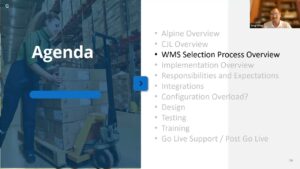Finding and implementing a new WMS is a large undertaking that requires a whole lot of research and diligence. If you’re searching for a new WMS, a great place to start information gathering is by reviewing the Gartner 2021 Magic Quadrant for Warehouse Management Systems Gartner Magic Quadrant. The research in the report offers a great way to gain an understanding of the current state of the WMS market. Here’s what you can expect…
Market definition & explanation
The report starts by defining a WMS as “a software application that helps manage and intelligently execute the operations of a warehouse or distribution center (DC).”
It then breaks the WMS market into five types of vendors:
“Application mega-suite vendors: Vendors that offer broad portfolios of applications across most application categories.
SCM suite vendors: These vendors offer a holistic WMS plus a portfolio of two or more applications focused primarily on SCM, like logistics, supply chain planning, customer service, or sourcing and procurement.
Specialist WMS suite vendors: Independent software vendors (ISVs) that focus primarily, but not exclusively, on holistic WMS suites. In addition to WMSs, they might offer additional, complementary capabilities.
Material handling equipment/automation vendors: Most material handling equipment (MHE) vendors focus on providing the electromechanical aspects of large-scale, automated warehouses. Many of these vendors also offer some WMS capabilities as part of their portfolio of products. Gartner only included MHE firms that demonstrated they routinely sell packaged WMS applications completely independently from their MHE.
Independent WMS component vendors: Not covered in this report, these vendors specialize in ISVs that focus exclusively on offering stand-alone components that can be used to supplement a WMS; they do not offer a full WMS.”
WMS Offerings
The report also details the areas WMS offerings tend to differ in, such as usability, adaptability, decision support, scalability both up and down market, and life cycle costs. There appears to be two types of WMS buyers. One is focused on features and functionality over cost. The other prioritizes ease of use, reliability, support, and lower cost of ownership.
Strengths and Cautions
The Gartner 2021 Magic Quadrant for Warehouse Management Systems also details each vendor’s strengths and cautions to be considered.
In conclusion
If you’re thinking of implementing a new WMS, we encourage you to start your search by visiting the Made4net website for a complimentary copy of the Gartner 2021 Magic Quadrant for Warehouse Management Systems.
Gartner, Magic Quadrant for Warehouse Management Systems, 30 June 2021, Simon Tunstall | Dwight Klappich
Gartner does not endorse any vendor, product or service depicted in its research publications and does not advise technology users to select only those vendors with the highest ratings or other designation. Gartner research publications consist of the opinions of Gartner’s research organization and should not be construed as statements of fact. Gartner disclaims all warranties, expressed or implied, with respect to this research, including any warranties of merchantability or fitness for a particular purpose.
GARTNER and Magic Quadrant are registered trademarks and service mark of Gartner, Inc. and/or its affiliates in the U.S. and internationally and are used herein with permission. All rights reserved.














